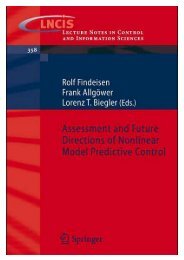The Stability of Linear Feedback Systems
The Stability of Linear Feedback Systems
The Stability of Linear Feedback Systems
You also want an ePaper? Increase the reach of your titles
YUMPU automatically turns print PDFs into web optimized ePapers that Google loves.
5.3 <strong>The</strong> Relative <strong>Stability</strong> <strong>of</strong> <strong>Feedback</strong> Control <strong>Systems</strong><br />
219<br />
"•<br />
,<br />
"<br />
"<br />
I<br />
• ,<br />
" "' ,,<br />
'.<br />
10<br />
Figure 5.6. Root locations in the s-planc.<br />
uation lie in the right half<strong>of</strong> the s-plane. However, if the system satisfies<br />
th_Hurwitz criterion and is absolutely stable, it is desirable to determine<br />
;ve srabilily; that is, it is necessary to investigate the relative damping <strong>of</strong><br />
root <strong>of</strong>the characteristic equation. Thc relative stability <strong>of</strong>a system may be<br />
as the property that is measured by the relative settling times <strong>of</strong>each root<br />
. <strong>of</strong>roots. <strong>The</strong>refore relative stability is represented by the real part <strong>of</strong>each<br />
Thus root'! is relatively more stable than the roots,,, 'I as shown in Fig.<br />
1be relative stability <strong>of</strong>a system can also be defined in terms <strong>of</strong> the relative<br />
coefficients f <strong>of</strong> each complex root pair and therefore in terms <strong>of</strong> the<br />
<strong>of</strong>response and overshoot instead <strong>of</strong>settling time.<br />
Hence the investigation <strong>of</strong> the relative stability <strong>of</strong> each root is clearly necesbecause,<br />
as we found in Chapter 4, the location <strong>of</strong> the closed-loop poles in<br />
'"Plane determines the performance <strong>of</strong> the system. Thus it is imperative that<br />
ioe:xamine the characteristic equation q(s) and consider several methods for<br />
determination <strong>of</strong> relative stability.<br />
use the relative stability <strong>of</strong> a system is dictated by the location <strong>of</strong> the<br />
<strong>of</strong>the characteristic equation, a first approach using an s-plane formulation<br />
extend the Routh-Hurwitz criterion to ascertain relative stability. This can<br />
ply accomplished by utilizing a change <strong>of</strong> variable, which shifts the s-plane<br />
in order to utilize the Routh-Hurwitz criterion. Examining Fig. 5.6, we notice<br />
a ~ft <strong>of</strong> the vertical axis in the s-plane to -(11 will result in the roots 'I, 'I<br />
on the shifted axis. <strong>The</strong> correct magnitude to shift the vertical axis<br />
be btained on a trial-and-error basis. <strong>The</strong>n, without solving the fifth-order<br />
iaI q(s), one may determine the real part <strong>of</strong> the dominant roots,,, 'I'<br />
Example 5.6 Axis shift<br />
the simple third-order characteristic equation<br />
q(s) ~ s' + 4s' + 6s + 4. (5.17)<br />
Y! one might shift the axis other than one unit and obtain a Routh-Hurwitz<br />
\\>tth~ut a zero occurring in the first column. However, upon setting the<br />
vanable Sn equal to s + I, we obtain<br />
"<br />
(5.18)










![[Language - English] - Life Skills - Writing](https://img.yumpu.com/44143758/1/190x245/language-english-life-skills-writing.jpg?quality=85)





